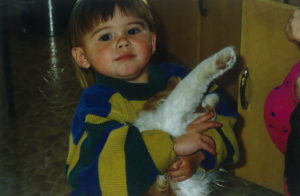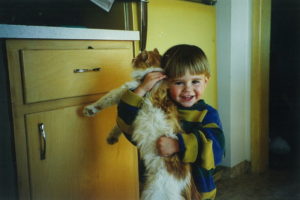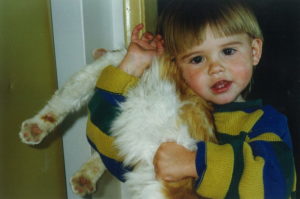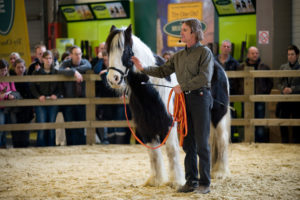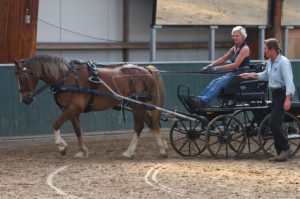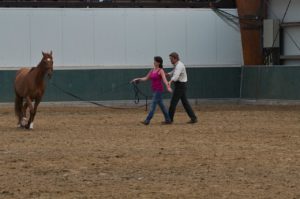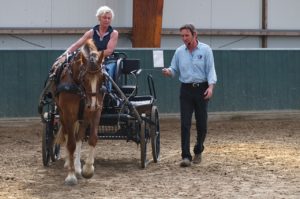5 STAR PRINCIPLES of IRWIN INSIGHTS
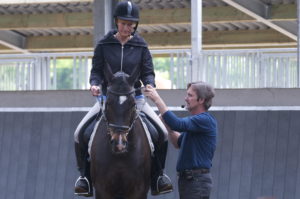 * Ask not what your horse can do for you; ask what you can do for your horse
* Ask not what your horse can do for you; ask what you can do for your horse
* We can’t control the horse. We control our responses to the horse
* Frame of Body = Frame of Mind
* Don’t pull the horse where to go, block where not to go
* Training Before Schooling
View our Skills Certificates and Certification Courses
Does the horse world really need another certification course?
Despite the recent surge in popularity with horsemanship certification programs there are still far too many horses that aren’t feeling the love. It’s what Chris Irwin often refers to as the child with a kitten analogy.
When we see a young child “cuddling” a kitten we are so often aware that the poor kitten isn’t feeling the love. Sometimes the kitten becomes frustrated and defends itself with a quick bite or scratch. The child drops the little feline and cries out “bad kitty”!
We know the kitten is not bad. We understand that the animal is not the problem at all. In the mind and heart of the child there was only pure innocence expressing love and affection. But, the simple truth is the body language of the child contradicted his or her true intention.
So now if we substitute child and kitten with horse and human we have a similar issue in a much bigger and more volatile context.
Global estimates from the World Horse Welfare Organization suggest that as many as 400,000 “problem horses” are slaughtered annually due to undesirable behavior.
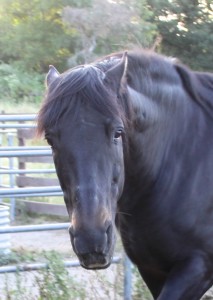 Then there are the horses who are not extreme problems but still live so visibly unhappy from man-made stress in their lives that they must express their anxieties by laying their ears flat back in anger, threatening to bite any who dare come near.
Then there are the horses who are not extreme problems but still live so visibly unhappy from man-made stress in their lives that they must express their anxieties by laying their ears flat back in anger, threatening to bite any who dare come near.
There are multitudes of “good horses” respectfully doing what they’re told. But these sad horses do so with braced backs, hollowed spines, with tails swishing in annoyance, many either avoiding or often leaning heavy against the legs and reins.
Of course, there are the “great horses” we see competing or performing circus tricks at shows with perfect obedience and super athleticism. But horses don’t lie. Look more closely and again we see their swishing tails whispering their annoyance. Tightly closed tails reveal their suspicions and fear. Wringing tails cry out in rage.
The child matures and learns how to handle kittens with more awareness for appropriate body language. Knowledge is power.
The Horse Sense Redefined Course is designed from Chris Irwin’s more then 35 years of competency-based success with a wide variety of breeds and horsemanship disciplines.
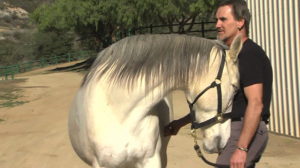 Chris leads his students through the horse industry’s deepest and most detailed process on how best to think horse, speak horse, and play horse games by horse rules. As students learn how to authentically earn respect, trust, focus and willingness from their horses, we see a new reality of body language emerge. Horses yawn and express their relief and appreciation for the change in the students approach. Level headed, calm and collected horses swing forward with curled tails, relaxed ears and soft eyes.
Chris leads his students through the horse industry’s deepest and most detailed process on how best to think horse, speak horse, and play horse games by horse rules. As students learn how to authentically earn respect, trust, focus and willingness from their horses, we see a new reality of body language emerge. Horses yawn and express their relief and appreciation for the change in the students approach. Level headed, calm and collected horses swing forward with curled tails, relaxed ears and soft eyes.
RIDING INSTRUCTION IS NOT HORSE TRAINING
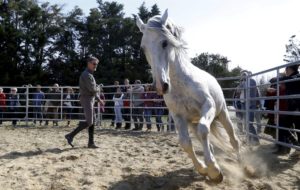 Riding instruction is not horse training anymore then simply able to send email is the same as computer programming and writing code.
Riding instruction is not horse training anymore then simply able to send email is the same as computer programming and writing code.
There are plenty of very competent and well-meaning riding instructors who thoroughly understand the theories of their chosen riding discipline. The problem is that the horses don’t often know or accept the theory. We can press the keys on the computer but what happens when the computer doesn’t operate the way we want it to?
The most natural response from any being is to resist attempts from another creature to dominate and control it. So resistance from horses to riding theory is natural and inevitable. When this happens the reality requirement of the moment shifts from riding instruction to horse training. The horse needs an empathetic behavior programmer who is a competent force to be reckoned with but nothing to be afraid of.
HANDLING B4 TRAINING / TRAINING B4 SCHOOLING
The Horse Sense Redefined Course fills in the gaps left by other programs that too often tend to “put the cart before the horse”. The Prime Ethos of the 5 STAR concepts of Irwin Insights is to ask not what the horse can do for us – but what can we do for the horse.
Before a young horse can be lead to a round corral, or into the arena for groundwork, someone needs to empathetically and effectively approach, catch and halter the horse. Feet need to be picked up, handled and managed. Horses need to be easy to lead in and out of box stalls, through gates and in and out of horse trailers. Long before they are ever ridden, horses need to learn how to stand still for vaccinations, de- worming and general grooming.
 We’ve put the cart before the horse when Veterinarians receive little or no training in equine behavior and essential horse handling during their formal education. And yet, Doctors of Veterinary Medicine will often risk their personal safety trying to be of service to difficult horses not trained well enough to stand quietly for handling. From trailer loading fiascos, to angry horses biting, to horses with ulcers, the issues seem to be endless.
We’ve put the cart before the horse when Veterinarians receive little or no training in equine behavior and essential horse handling during their formal education. And yet, Doctors of Veterinary Medicine will often risk their personal safety trying to be of service to difficult horses not trained well enough to stand quietly for handling. From trailer loading fiascos, to angry horses biting, to horses with ulcers, the issues seem to be endless.
Riding students say their goal for the lesson is to be able to jump bigger fences but their horse won’t accept the bridle. The dressage rider wants to work on straightness, collection and extension but her horse is so stressed it can’t stand still for mounting.
This course defines a clear distinction between understanding theory and developing competent hands-on essential training skills. In all groundwork handling exercises, groundwork training, riding, driving, and coaching with students and horses, Irwin Insights maintain a constant focus that the trainer must align to the need of the horse – not the horse to the structure of a course.
BETTER COACHING
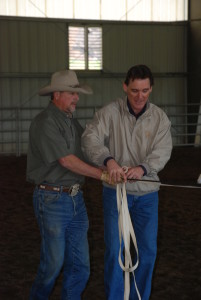 It’s a disturbingly ironic statement that is all too common among horse professionals: “I wish I could just work with horses for a living and not have to deal with people.”
It’s a disturbingly ironic statement that is all too common among horse professionals: “I wish I could just work with horses for a living and not have to deal with people.”
This is sad because if a horse trainer or riding instructor doesn’t work well with people then they can’t effectively help people learn how to be better with their horses.
Feel good esoteric coaching with metaphors doesn’t develop real skills that lead to meaningful change. Horses and people both need competent coaching from empathetic professionals with the diagnostic abilities and consistent communication skills needed to be proactive in setting both horse and human students up for success.
WHY IRWIN INSIGHTS?
Chris Irwin is a world-renowned horseman, personal coach, and author of the international best-selling books Horses Don’t Lie and Dancing With Your Dark Horse.
Ireland’s Equestrian magazine said he is “more horse then human”. In France, the media say he has written the bible on horsemanship. From standing room only University lectures on equine behavior and essential handling skills, to training the trainers in horsemanship, riding, driving, Mounted Police training, Therapeutic Riding and Equine Assisted Coaching, Chris Irwin is the most innovative leader working with horses today.
From training Wild Mustangs in Nevada to achieve 18 U.S. National Championships in riding and driving events, to training the trainers with challenging horses to win national Grand Prix dressage competitions in Canada and Europe, Chris Irwin’s Insights on Horse Sense Redefined shine a light on the marketing illusions of today’s horse industry to reveal the true depths of awareness for change that horses need to see from humans.
Chris refers to his coaching as “working wisdom for authentic empowerment in an artificial world.” Horse & Rider magazine said, “nobody explains the horse human relationship better then Chris Irwin.” Hall of Fame Jockey, Sandy Hawley, said, “I wish I could’ve ridden a Chris Irwin horse.” But Leif Hallberg best sums up his creative genius in her groundbreaking book, Walking The Way Of The Horse, by proclaiming that Chris Irwin’s Insights are “bold and possibly the most useful and impactful concepts”.
PRE-REQUISITE ABILITIES
The Irwin Insights Horse Sense Redefined Courses are designed to significantly expand upon the existing knowledge and skills of experienced horse enthusiasts, amateur and professional trainers, riding coaches, Veterinarians, Farriers, and Equine Assisted Facilitators. To participate in the Horse Sense Redefined Courses students must already be reasonably experienced, effective and confident with horses.
ENROLL YOUR HORSE IN TRAINING
If you have a horse you would like Chris and his Trainers in Training to work with – but you are not able to physically participate as a student – please contact Chris at info@chrisirwin.com to make special arrangements to enroll your horse in a clinic.
TOO MUCH HORSE!?!
A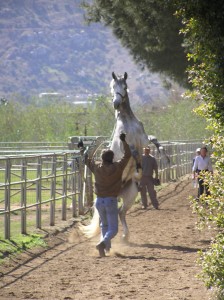 ny student with an extremely difficult horse requiring direct hands-on training skills beyond their own personal ability must contact Chris for discussion in advance of the clinic.
ny student with an extremely difficult horse requiring direct hands-on training skills beyond their own personal ability must contact Chris for discussion in advance of the clinic.
All participates in the Horse Sense Redefined Courses must work with a horse whose training needs are compatible with the ability of the student. In some cases, Chris will ask a more advanced student to work with the horse when someone has too much horse for his or her current level of ability. A horse with a more appropriate level of challenge will be assigned to the student. Chris will reunite the original horse and student when they can work together in harmony.
Inevitably, there are the extremely challenging horses that need help and Chris then works personally with the horse in a demonstration. Typically, later in the demo Chris, will “hand the reins” of training over to an appropriate student for further training during the clinic.
SKILLS CERTIFICATES & MASTERS CERTIFICATION PROGRAM
Customize Your Program to Align to Your Goals!
Skills Certificates can be achieved as stand alone independent goals or accumulated for Masters Certification.
For instance, Marc has a personal goal to achieve his level 2 Riding Skills Certificate. He’s not interested in extensive groundwork training or coaching.
Marie is also training for her level 2 Riding Skills Certificate. But Marie volunteers as a trainer and coach at her local therapeutic riding centre where she often works with both horses and people under special circumstances with unique needs. 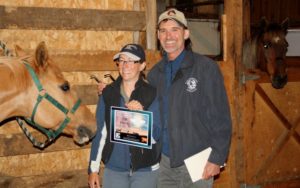 So Marie is filling her trainer toolbox with numerous other Skills Certificates in handling, groundwork and coaching, so she can accumulate 10 credits to reach her goal of Level 1 MASTERS CERTIFICATION.
So Marie is filling her trainer toolbox with numerous other Skills Certificates in handling, groundwork and coaching, so she can accumulate 10 credits to reach her goal of Level 1 MASTERS CERTIFICATION.
Frank in Belgium is interested in driving horses and corporate EAPD coaching. So Frank’s course of required skills does not include the same exercises as Tracy in British Columbia who is a professional jumper trainer and coach. Then there are the specific Irwin Insights exercises relative to handling horses in the Veterinary clinic or leading horses as a side-walker volunteer at a therapeutic riding centre.
What the Mounted Police Horse trainer needs for riding horses into riot control situations is not the same program we design for therapists, teachers and life-coaches working with horses in Equine Assisted Programs. And of course, there are those keen and courageous students who aspire to be the first to ride the young horses or help with the more dangerous “problem horses”.
SKILLS CERTIFICATES = CREDITS
Each Skill Certificate of Achievement = 1 credit
Skills Certificates of Achievement will be awarded for individual exercises in the categories of groundwork, riding, driving, coaching, and EAPD (equine assisted personal development).
MASTER CERTIFICATION LEVELS 1-4
The Master Certification Program encourages students to design your own course of study by achieving and accumulating credits from the most appropriate Skills Certificates aligned with your personal goals.
Each Skill Certificate of Achievement = 1 credit.
Level 1 Master Certification requires 10 credits.
Level 2 Master Certification requires 15 credits.
Level 3 Master Certification requires 20 credits.
Level 4 Master Certification requires 25 credits.
Download Examples of Custom Certification Scenarios
GROUNDWORK SKILLS CERTIFICATES
LEVELS 1-2-3
Level 1 Horse Handling Essentials = 1 credit
Level 1 Loose Lead = 1 credit
Level 1 Lunge = 1 credit
Level 2 Horse Handling Essentials = 1 credit
Level 2 Loose Lead = 1 credit
Level 2 In-Hand = 1 credit
Level 2 Lunge = 1 credit
Level 2 Round Corral = 1 credit
Level 2 Long Lining = 1 credit
Level 3 Horse Handling Essentials = 1 credit
Level 3 Loose Lead = 1 credit
Level 3 In-Hand = 1 credit
Level 3 Lunge = 1 credit
Level 3 Round Corral = 1 credit
Level 3 Long Lining = 1 credit
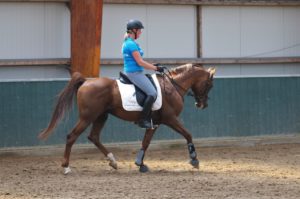 RIDING SKILLS CERTIFICATES
RIDING SKILLS CERTIFICATES
Level 1 Riding = 1 credit
Level 2 Riding = 1 credit
Level 3 Riding = 1 credit
DRIVING SKILLS CERTIFICATES
Level 2 Driving = 1 credit
Level 3 Driving = 1 credit
EAPD SKILLS CERTIFICATES
Level 1 @ 2 day into EAPD workshop = 1 credit
Level 2 @ 3 day EAPD 2 workshop = 1 credit
Level 3 @ 3 day EAPD 3 workshop = 1 credit
COACHING SKILLS CERTIFICATES
Level 1 Coaching = 1 credit
Level 2 Coaching = 1 credit
Level 3 coaching = 1 credit
* To participate in a coaching skills sessions a student must first have achieved a level 2 skills certificate in the exercise they want to coach.
SKILLS CERTIFICATE AND COURSE OUTLINE
Constant Awareness Essentials
* Fundamental body language differences between predator & prey
* Understanding psychological differences between predator & prey
* 3 energies: push, block, draw (in horse and human)
* Human core communication awareness
* No push zone in front of horse
* Distinction of “in-hand” with blocking contact
* 11 buttons on the horse
* Distinction between “catching” and “capturing” the horse
* Bending button / girth line
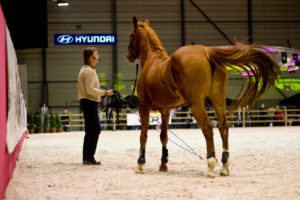 * 5 toplines and their physiological cause and effect on behavior
* 5 toplines and their physiological cause and effect on behavior
* “Tell-tail signs” – 6 emotional messages from the tail of the horse
* Ear messages (facial expressions of horse)
* 2 lines: define herding boundaries and how to align accordingly
* Breathing
* Approaching horse (energies & lines) in stall or in open space
* Catch (not capture) horse in stall or open space
* Haltering as catching not capturing
* In hand (alignment: front/next/behind/contact/use of whip
* Loose lead (alignment, how to push horse into draw)
* When and why “in-hand” and when and why, “loose lead”
 * Stand still and straight (boundaries, blocking techniques)
* Stand still and straight (boundaries, blocking techniques)
* Stand in bend
* Backing up – how to respond when horses back up in avoidance
* Using a dressage whip as an extension of your body language
* Training horse for calm and straight in cross ties
* Correct diagonals and lateral balance when picking up feet
* Consistently connected and speaking horse during grooming and dressing
GROUNDWORK TRAINING LEVEL 1
Training before Schooling
Handling: certificate = 1 credit
* Refined haltering /bridling (massage ears, mouth)
* Approaching horse with surcingle / saddle pad / blanket / saddle
* Standing still in bend against wall
* Snaffle bits: purposes for D-snaffle, loose ring snaffle, full cheek
* Use of whip for horse language of levels, bends, gestures
Loose lead: certificate = 1 credit
* Alignment of feet, hips, shoulders, whip, arcs and angles …
* Training for focus from horse (address girth line or hip)
* Changes of direction (more accurate shoulder boundaries)
In-Hand: certificate = 1 credit
* Alignment @ shoulder with contact (halter & bridle)
* Forward into consistent contact
* Timing turns /use of whip (footfall/barrel swing) to help bend
* Stepping out to turn in – wheelbarrow analogy
* The head of the horse must be last to turn, not first!
* Level & relax forward into turn on forehand– why and how
* Half halting into halt without pulling
* Turn on forehand halts (how, when and why)
Lunge: certificate = 1 credit
* Alignment of 3 energies to initiate lunge – wheelbarrow analogy
* FORWARD! NO BACKING UP! (No mixed messages from core)
* Alignment of 3 body energies while horse is on circle
* Push hips out and draw horse into halt
* Line awareness for Leadership
* Walk and trot transitions
GROUNDWORK TRAINING LEVEL 2
From Training to Schooling
Handling: certificate = 1 credit
* Cross ties (straightening – frame of body/frame of mind)
* Maintaining focus from horse while in a distracting environment
* Physiotherapy stretches for horse
* Body language in the box stall: alignment body to body
Round Corral: certificate = 1 credit
* Getting off on the correct foot
* Awareness of lines
* Why herd horse into the fence?
* Invite horse in with pushing hips out, draw & line setting
* Horse following close and focused (ref. loose lead)
Loose lead: certificate = 1 credit
* Spine crossing (more precise boundaries awareness)
* Better bend, focus and forward with awareness for timing
* Open elbow, wrist awareness
* Human & horse consistently transitioning on correct diagonal foot
* Change from loose lead to in hand and vice versa
In-Hand: certificate = 1 credit
* Taking off on the correct foot
* Halt and back up
* Timing all transitions on outside diagonal leg
* Straight before changing directions
*Turn on forehand / turn on haunches collected with half-halt
* Lead horse through fear / past suspicious objects
* Massaging contact. Why, when, how, timing
Lunge: certificate = 1 credit
* Refinement of body alignment of 3 energies
* Fluency / finesse with transitions
* Contact refinement & consistency during rapid transitions
* Whip talk: Cause & Effect as horse interprets use of whip
* Spiral circles in and out – when, why and how
* Move (floating) lunge circles – when, why and how
* Cantor/gallop – most common problems to fix
* Vienna rein: when and why? When/why not? How to adjust?
* Outside side rein – when, why, how. Common problems to avoid
* Wrist control / open elbow
* Full body wrap to prep for long lining / learning how to learn
Long Lining: certificate = 1 credit
* Alignment behind and beside the horse
* Good Hands – streaming release of contact/blocks for transitions
* Change of directions: Turn without pulling! Wheelbarrow hips
* Contact: purpose of holding or redefining outside shoulder
GROUNDWORK TRAINING LEVEL 3
Schooling
Handling: certificate = 1 credit
* Clipping, spraying, introducing the water hose for bathing
* Trailer loading
* Standing calm at halt when facing fear in challenging environments
Round Corral: certificate = 1 credit
* Same as level 2 but with more challenging horses
* Increase transitions for respect/focus from challenging horses
* Up Against the Wall = conflict resolution with difficult horses.
Loose lead: certificate = 1 credit
* Transitions from loose lead to in hand and vice versa
* How to lead an anxious/stressed horse too pushy for In-Hand
In-Hand: certificate = 1 credit
* Collection and extending strides + lateral gymnastics
* Fluent and fast transitions
* Transitions from in-hand to loose lead to lunge
* Refined straightness
* Collected trot
Lunge: certificate = 1 credit
* Lunge with double lunge lines – move circles – change directions
* Transition from double lunge to long lining to double lunge
* Consistent contact – taking up slack with whip hand perfection
* Cavaletti work / small jumps
* Outside blocking side-rein – how and why
* Up against the wall refinement
* Transitions into straight lines against arena wall during lunge
Long lining: certificate = 1 credit
* Transitions from long lining to lunge
* Collection and lateral work
* Check – rein: why and how
* Streaming release hand contact into straightness
* Swinging turns on forehand into halt. When and why
LEVEL 1 RIDING SKILLS CERTIFICATE
Level 1 Riding Skills Certificate = 1 credit / Training b4 Schooling
* Training bits function
* Mounting (bend, level headed, chute against wall)
* Alignment in saddle: spine to spine, core, shoulders, elbows, hips
* Energies in the saddle: push, block, draw – timing of seat and legs
* Rhythm of swing for timing bend – inside leg and turns from seat
* Contact: boundaries blocking where not to go (river analogy)
* Open reins: why and how (funnel for firmer proactive block)
* Read-ride bend knowing true inside/outside of horse
* Why bend, why over bend, why contra bend
* Riding from seat as primary aid
* Correct diagonals according to bend of horse not direction of travel
* Half-halting from core as blocking energies – not hands pulling
* How to empower half- halt with turn on forehand
* Halt in bend – why and how / Order and timing of aids into halt
* Backing up without pulling
* Why over bend during difficult transitions?
* Transitions: halt/walk – halt/backing up – walk/trot/
* Use of spurs as acupressure massage aids
* Inside leg to stretch horse down, outside leg to lift and lighten up
* Use of dressage whip as extension of riding aids
Level 2 Riding Skills Certificate = 1 credit
From Training to Schooling
* Strategic riding: awareness extension of self, horse, environment
* Reading the horse’s frame and responding with proactive aids
* Perfecting timing of transitions & change of direction
* Perfecting timing halt halts
* Halt to walk starting on outside leg
* Changing bends within less steps
* Lengthening & shortening strides
* Finding the clutch with transitions
* Transitions for collection and extension
* Cavaletti: how and why the horse benefits
* Turn on forehand/turn on haunches: differences, why and how
* Lateral work: introduction to leg yielding
* Riding with 2 whips as extension of aids
* Calm and collected canter departures from seat
* Simple lead changes
Level 3 Riding Skills Certificate = 1 credit
Schooling
* Calm & Collected in stressful environments
* Advanced transitions: Halt to back up to canter pirouette
* Advanced cavaletti work
* Flying lead changes
Specific for Dressage Schooling Skills Certificate
* Self-carriage
* Straightness
* Advanced lateral work: shoulder in, sidepass, half pass, …
* Refinement of canter pirouette
* Multiple high quality transitions and changes
* Extended trot
Specific for Jumper Schooling Skills Certificate
* When in full seat and when in forward seat and why
* Why Collection is Critical! Loading the arrow
* Jumping with consistent contact/following hand
* Maintaining calm, confident horses over multiple obstacles
* Knowing the limits for you and your horse
Specific for Western Schooling Skills Certificate
* Jog – speed control from seat instead of hands
* Lope transitions in true bend
* Reining one hand – it’s NOT what people think!
* Rollbacks
* Spins
* Which horses, when and why, progress into leveraged “full bridle”
and coming soon…
LEVEL 1 DRIVING SKILLS CERTIFICATE = 1 CREDIT
LEVEL 2 DRIVING SKILLS CERTIFICATE = 1 CREDIT
LEVEL 3 DRIVING SKILLS CERTIFICATE = 1 CREDIT
LEVEL 1 EAPD SKILLS CERTIFICATE = 1 CREDIT
LEVEL 2 EAPD SKILLS CERTIFICATE = 1 CREDIT
LEVEL 3 EAPD SKILLS CERTIFICATE = 1 CREDIT
LEVEL 1 COACHING SKILLS CERTIFICATE = 1 CREDIT
LEVEL 2 COACHING SKILLS CERTIFICATE = 1 CREDIT
LEVEL 3 COACHING SKILLS CERTIFICATE = 1 CREDIT
